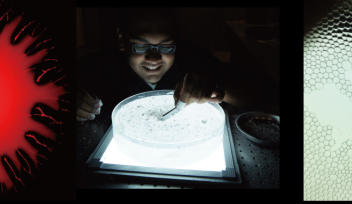Gel, masks, and face shields: Researchers use specific skills to help Okinawa

The number of COVID-19 cases continues to rise in both Okinawa and mainland Japan. Although guidelines about social distancing and self-isolating are important to adhere to, researchers from many different units at the Okinawa Institute of Science and Technology Graduate University (OIST) have started to think creatively about how they can use their specific skills to help Okinawa in other ways.
Manufacturing Masks with a Cotton-Candy Machine
With COVID-19 causing a shortage of essential protective material like face masks Professor Mahesh Bandi, who runs the Nonlinear and Non-equilibrium Physics Unit, has found a way to manufacture masks, inspired by the principle of N95 ones, using a process developed in-house at OIST.
“Neither the homemade cloth masks nor most commercial masks can filter the COVID-19 virion,” said Professor Bandi. “The N95 mask is the only available design capable of stopping the virion because it contains an electrocharged layer.”
Although the technique used to manufacture these masks is hard to replicate with everyday material, Professor Bandi stressed that it’s not impossible.
“A simple way to generate the necessary fabric is to use a slightly modified cotton candy machine,” said Professor Bandi.
A cotton candy machine is made up of a drum that sits on a fast-spinning container. The container has small holes in it which, in traditional situations, the caramelized sugar flows through before it turns into cotton candy. Professor Bandi modified the machine by setting up a 12-24 voltage DC electric field using a regular car battery.

Instead of sugar, Professor Bandi poured a powdered polypropylene polymer into the drum. This polymer could be created from any polypropylene plastic bottle. When the machine began to spin it processed the polymer to generate a fabric comprising of electrocharged nanofibers.

From there, making the mask was relatively straightforward. Two batches of the fabric at a zero electric field were produced for every three batches of the fabric at an electric field of 12-24 voltage using a car battery. The fabrics were pressed between two clean, flat surfaces. They were then laid out to form five layers. The fabric created at a zero electric field served as the outer layers, whereas the ones created at 12-24 volts formed three inner layers. This layered material was then cut into 6 cm x 6 cm pieces, folded, and stitched together.
By using this process, Professor Bandi fabricated the material and method necessary to replicate medical-grade face masks. In a time of crisis, without access to the traditional N95 masks, this alternative may prove to be lifesaving. To find out more, have a look at Professor Bandi's web page N95-electrocharged filtration principle based face mask design using common materials.
This project was interdisciplinary and included the help of many collaborators throughout OIST including Professor Matthias Wolf who leads the Molecular Cryo-Electron Microscopy Unit, Ms. Noriko Ishizu and the team from the Engineering Support Section, and the OIST Imaging Section.
Alcohol-based Gel
Led by OIST PhD students Sébastien Lapointe, from the Coordination Chemistry and Catalysis Unit, and Sandrine Burriel, from the Cell Signal Unit, a project is underway to supply the campus, Onna Village and Chubu Hospital with an increased amount of much needed alcohol-based gel. Called ‘OIST gel’, this solution is produced in accordance with the World Health Organization’s ‘Guidelines on Hand Hygiene in Healthcare’.
“Although handwashing with soap and water for 20 seconds or more is more effective than using an alcohol-based gel, it is not always possible to do so while on essential outings such as grocery shopping,” said Sébastien. “In these cases, the alcohol-based gel is a useful alternative to reduce virus spread.”
The team currently aims to produce at least 400 liters of OIST gel. 50 liters will be for within the OIST community, while the rest will be donated to the local Onna community and Chuubu Hospital. Supplies have been received to the OIST campus and production began in mid-April.
“This project has 25 volunteers from various OIST units and backgrounds,” said Sandrine. “Those with the necessary laboratory safety training will make and bottle the gel. Other volunteers have designed the label and are coordinating with local organizations to make sure the gel can be safely and effectively distributed.”

3D Printed Face Shields
An OIST research team from the Mathematics, Mechanics, and Materials Unit and the Micro/Bio/Nanofluidics Unit has produced 3D printed face shields that can effectively block coronavirus droplets and aerosols, which is especially important for frontline medical professionals. Research technicians Michael Grunwald and Kazumi Toda-Peters and junior research fellow Paul Hsieh-Fu Tsai collaborated to redesign and print the face shields under the guidance of Dr. Tomoari Mori from the OIST Health Clinic. They are now producing hundreds of face shields that will soon be ready for distribution.
“There is increasing evidence that COVID-19 can be spread through the sneezes and coughs of infected people and these micron size droplets and aerosols can infect healthcare workers through the eye,” said Michael. “Face shields are usually put on top of the surgical or N95 masks that healthcare workers wear as an additional protective barrier to combat COVID-19 infection.”
Michael added that over the last two months, the global 3D printing community has been hard at work creating and sharing designs to help combat the COVID-19 pandemic. “At OIST, we modified a design from the 3D printing company Prusa to minimize the material and time needed to print the headband, as well as to accommodate the laser-cut face shield material that we could source here in Japan.”
One point that was emphasized was the importance of not touching the front of the face shields at any time after putting it on.
“After a face shield is used, consider that its entire surface is contaminated,” said Paul. “When removing it, make sure to touch the headband instead of the front shield, disinfect all the surfaces properly and don't forget to wash your hands with soap."
After a meeting with the Okinawa Prefectural Government in early April, the research team has been working hard to fulfill their request for 800 face shields for distribution to hospitals all around Okinawa.
This project continues to receive a lot of help from the OIST community. Professor Izumi Fukunaga from the Sensory and Behavioural Neuroscience Unit shared her newly ordered 3D printer to boost the high throughput capacity. Ph.D. student Ainash Garifullina from the Micro/Bio/Nanofluidics Unit is helping to organize student volunteers for post-treatment and assembly of the face shield. Kieran Deasy from the Engineering Support Section, Ankur Dhar, Ph.D. student from the Quantum Wave Microscopy Unit, and Jeremie Gillet from the Graduate School are helping with the laser cutting of rubber parts and are monitoring the printing process.
The team has also benefited from support from members of other research units who shared their raw printing materials due to the global shortage of 3D printing materials. Jeffery Prine from the Communications and Public Relations Division prepared the DIY illustration to help the healthcare workers assemble the 3D printed parts of the face shields on site. And the Technology Development and Innovation Center helped with acquiring printing material and provided their incubator facilities for the 3D printing.

UVC Sterilization Units
A team from OIST, led by Professor Keshav Dani from the Femtosecond Spectroscopy Unit has designed and built an apparatus that sterilizes Personal Protective Equipment (PPE), such as N95 masks, using short-wavelength ultraviolet (UVC) light. The apparatus also compares the post-sterilization performance of the masks to their original specifications. Each unit can disinfect around 400 N95 masks a day, with the hope that a limited supply of masks could be extended.
The first step involved a collaboration between Hemanta Sarmah and Nao Ohmine-san of the Cell Signal Unit, Ankur Dhar of the Quantum Wave Microscopy Unit, and Vivek Pareek, Abdullah Al Mahboob, and Viktoras Lisicovas of the Femtosecond Spectroscopy Unit. Through a direct measurement, they established the dose of UVC needed to effectively sterilize the N95 masks and found that it was 100 to 1000 times higher for an N95 mask than previously reported on other surfaces.
The team also developed a test to check the filtration efficiency of the N95 masks after sterilization. They used a CPR dummy with sensors at the back of its throat. These sensors counted how many sub-300 nm particles came through when the dummy simulated a breath of air. This test was performed both with and without an N95 mask on the dummy, to determine the filtration efficiency of the mask. N95 masks should ideally be able to filter 95% of particles under 300nm. The team confirmed that multiple rounds of UVC sterilization at the right dose left the filtration capability of the mask unchanged.
“We found that even after 30 rounds of sterilization, these masks performed well. To us, the limiting factor seems to be general wear and tear, rather than the sterilization process,” said Professor Dani. “We are working now with one of the local hospitals to do daily filtration-efficiency tests of the masks after they are used by medical professionals and after exposure to the required UVC sterilization dose. This study will provide a very solid data point on how often one can safely re-use N95 masks.”
To be able to sterilize the masks in the hospitals itself and to conduct the filtration efficiency tests, the group has had to develop easy-to-use, safe and compact apparatus that can be operated by hospital staff. With these constraints in mind, and much-needed help from the Engineering Support Section and Buildings and Facilities Management Division, the team has designed, built and tested multiple sterilization units. The first few units have been delivered to hospitals in Naha and additional units are under construction.

By developing the masks, gel, face shields, and UVC sterilization units OIST researchers are hoping to support and aid the people of Okinawa during this difficult time. Researchers will continue to explore other ways they can provide assistance, such as through developing antibody tests and modelling the spread of the virus. The latest information is available on COVID-19 Research Community Projects website.
For press enquiries:
Press Inquiry Form




















